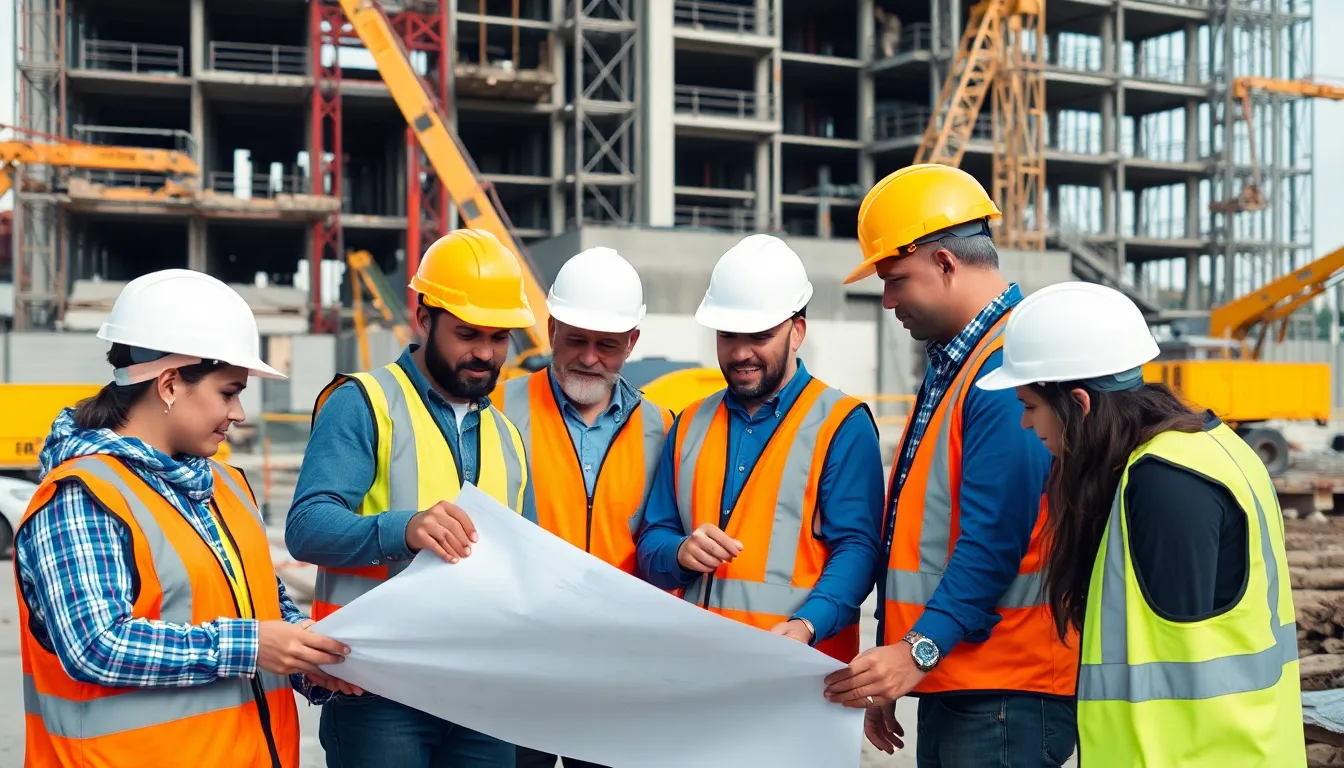Building construction law might sound like a snooze-fest, but it’s the unsung hero of every successful project. Imagine trying to build your dream home without knowing the rules—chaos would reign! From permits to contracts, understanding these laws can save headaches and dollars.
Table of Contents
ToggleOverview of Building Construction Law
Building construction law governs the processes involved in construction projects. Compliance with these laws ensures projects meet safety standards and legal requirements.
Definition and Scope
Building construction law encompasses statutes, regulations, and case laws that apply to the construction industry. These legal frameworks address areas such as zoning, permits, contracts, and safety codes. Courts interpret these laws, providing guidelines for dispute resolution and enforcement. The scope includes commercial, residential, and infrastructure projects. A thorough understanding of these laws is essential for all stakeholders, including contractors, architects, and real estate developers.
Importance in the Industry
Building construction law plays a vital role in protecting the interests of all project participants. It minimizes risks associated with disputes and non-compliance. Adhering to these laws helps avoid delays and costly fines. Insurance and bonding requirements address potential liabilities and protect against financial losses. Construction professionals who understand these laws foster smooth project execution and enhance stakeholder confidence.
Key Legal Principles

Understanding key legal principles is crucial in building construction law. These principles govern the relationships and responsibilities of all parties involved in a construction project.
Contracts in Construction
Contracts in construction outline responsibilities, timelines, and payment terms for stakeholders. They form the basis for project execution and serve as legal protection in case of disputes. Essential contract types include general contracts, subcontractor agreements, and construction management contracts. Clear definitions of scope, deliverables, and schedules enhance communication. Discrepancies in contract interpretation may lead to costly delays or disputes. Contract law mandates that all parties follow agreed terms, ensuring accountability throughout the project lifecycle.
Liability and Negligence
Liability and negligence significantly impact construction projects. Projects often face risks associated with workplace injuries or property damage. Contractors bear primary responsibility for ensuring safety on the job site. Compliance with safety regulations reduces the likelihood of accidents. If negligence occurs, affected parties may file claims for damages, bringing legal challenges to the forefront. Liability laws vary by jurisdiction but generally hold parties accountable for failure to adhere to established safety standards. An understanding of liability protects stakeholders from potential financial losses and promotes best practices on site.
Regulatory Framework
Building construction law operates within a regulatory framework that includes multiple levels of governance. Stakeholders must navigate federal, state, and local regulations to ensure compliance throughout project execution.
Federal Regulations
Federal regulations establish nationwide standards for health and safety in construction. The Occupational Safety and Health Administration (OSHA) enforces safety provisions that protect workers on job sites. Environmental Protection Agency (EPA) regulations govern issues related to air and water quality during construction activities. Contractors must adhere to these regulations to avoid severe penalties and ensure public safety.
State and Local Laws
State laws further shape building construction practices by addressing specific zoning requirements and construction codes. Each state has its own set of laws that dictate permits, inspections, and construction standards. Local governments also impose regulations that reflect community needs and safety concerns. Compliance with these local laws is crucial for project approval and successful completion.
Dispute Resolution in Construction
Disputes in construction projects arise from various issues, including contract misunderstandings and delays. Effective resolution methods are crucial for maintaining project timelines and budgets.
Mediation and Arbitration
Mediation serves as a voluntary process where a neutral third party helps facilitate discussions between disputing parties. Both sides can express concerns and work towards a mutually agreeable solution. Arbitration involves a binding decision by an impartial arbiter after reviewing evidence and hearing arguments. This method provides a quicker alternative to litigation while retaining the formalities of a judicial process. Arbitration decisions typically include enforceable rulings, ensuring parties adhere to outcomes. Overall, these methods foster cooperation and limit disruptions during construction activities.
Litigation Considerations
Litigation stands as a more formal approach to resolving disputes, often involving lengthy processes and increased costs. This method requires filing complaints and attending court hearings. The public nature of litigation may hinder reputations and relationships among parties. Preparation involves gathering evidence, witness testimonies, and expert opinions, which adds complexity. Outcomes depend on judicial rulings, which may prolong resolution timelines. Understanding these factors assists stakeholders in deciding the most suitable conflict resolution strategy, balancing efficiency and effectiveness.
Recent Developments and Trends
Recent developments in building construction law highlight key industry shifts, including advancements in technology and changes to safety regulations. Stakeholders must stay informed to adapt efficiently to these dynamic factors.
Emerging Issues in Building Construction Law
Technological advancements raise new challenges, such as potential liability associated with the use of building information modeling (BIM). Environmental regulations increasingly influence construction practices, compelling companies to employ sustainable materials. Cybersecurity threats also pose risks, as digital contracts and project management systems become more prevalent. Stakeholders need to ensure that their practices remain compliant with evolving laws surrounding these issues, encompassing data protection and privacy mandates. Furthermore, an ongoing labor shortage has led to heightened scrutiny of workforce safety regulations and compliance.
Case Law Updates
Recent case law highlights critical shifts affecting stakeholders in the construction sector. Construction delays frequently lead to disputes, resulting in new judicial interpretations of contract provisions. A notable case in California clarified the enforceability of liquidated damages clauses, leading contractors to reassess contract risks. Courts now more rigorously enforce safety obligations, often ruling against negligent parties responsible for workplace incidents. Additionally, rulings regarding project financing dispute resolutions illustrate the increasing importance of transparent contractual obligations. Tracking these developments aids stakeholders in minimizing risks and refining their contractual agreements.
Building construction law plays a vital role in the successful execution of construction projects. By understanding the legal frameworks and requirements, stakeholders can navigate potential pitfalls and ensure compliance with safety and regulatory standards. This knowledge not only protects their interests but also fosters a collaborative environment among all parties involved.
As the industry evolves with technological advancements and changing regulations, staying informed is essential. Proactive engagement with legal developments and dispute resolution strategies can significantly enhance project outcomes. Ultimately, a solid grasp of building construction law is indispensable for minimizing risks and achieving successful project completion.



